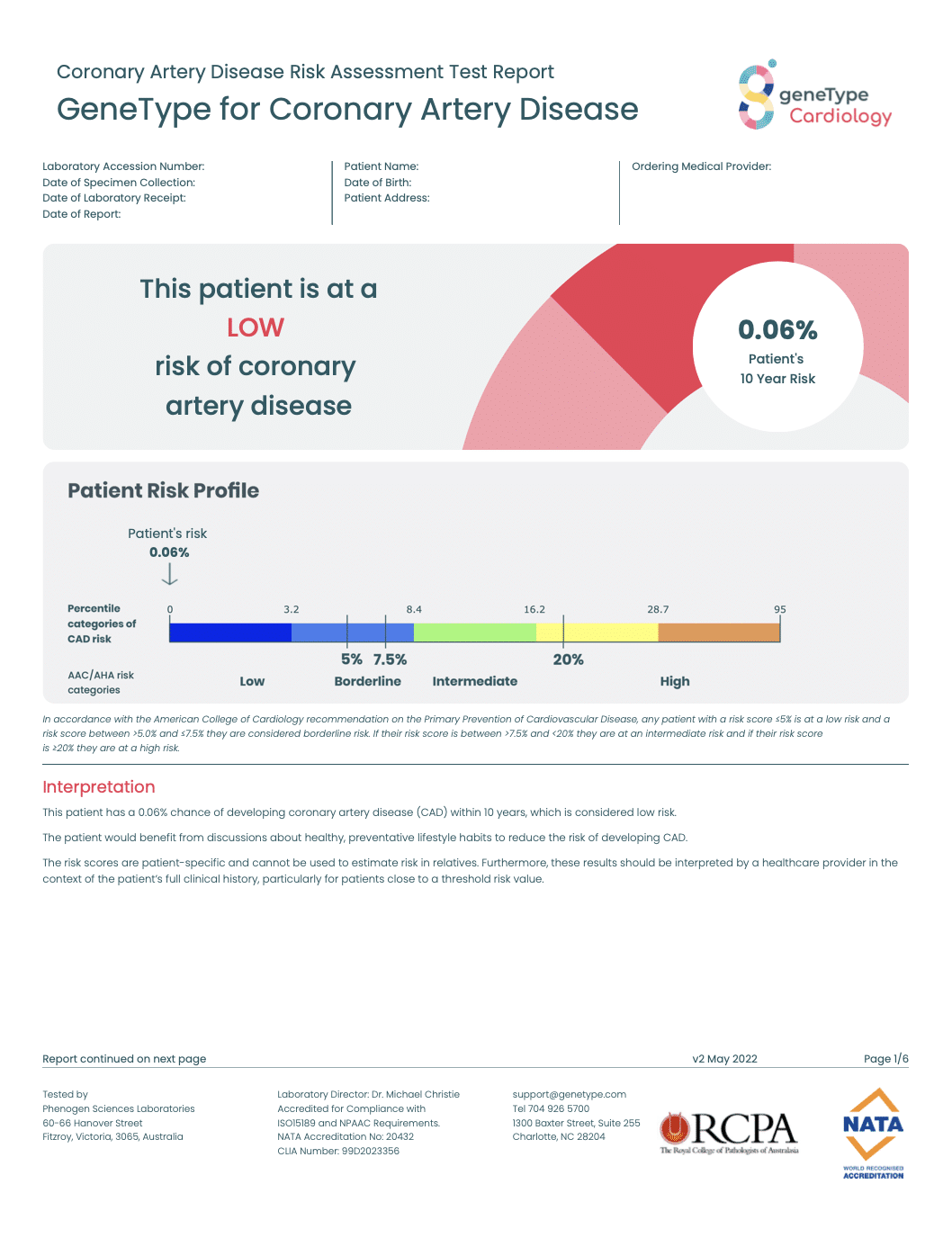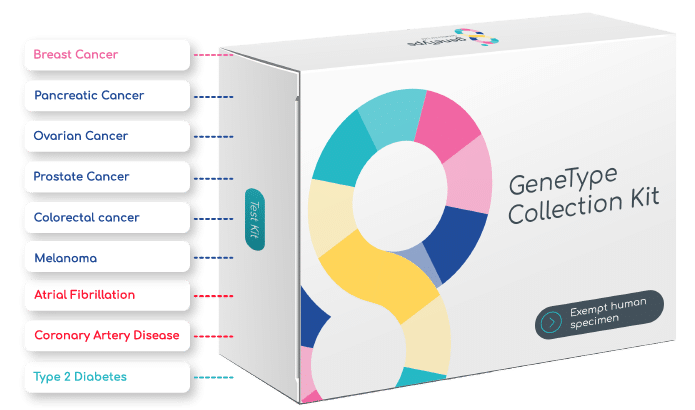Optimise the management of your patients at risk of coronary artery disease
The most common form of heart disease and largely preventable if the uncontrolled risk factors can be addressed proactively in the patient population1,2


An integrated risk assessment when you need it
GeneType for Coronary Artery Disease integrates familial, clinical and genetic risk factors.
With this one test, GeneType also integrates the Framingham model risk factors to deliver a holistic view of your patient’s coronary artery disease risk in a single risk score.
Don’t let hidden baseline risk go unnoticed³
There are many strategies to proactively manage your patient’s risk of developing coronary artery disease. For example, treatment for hypertension and elevated cholesterol.³
However, sometimes, the recommended action is not so clear.
When a patient presents with an unclear scenario, such as a healthy, active average-weight, middle-aged adult with mildly elevated blood pressure but no family history or hypertension, traditional risk models would suggest that they are not necessarily a candidate for medical intervention.
With geneType, you can incorporate an additional risk factor that looks at underlying common genetic markers associated with coronary artery disease. This risk factor may reveal a patient’s hidden baseline risk.

The geneType patient

If you’re using the Framingham model to assess risk in any of your patients aged between 40 and 85 years, you may need to look beyond the obvious to reveal their hidden risk factors.
GeneType allows you to integrate the Framingham model with your patient’s genetic, clinical and familial risk factors to deliver a single 10-year risk score.
Let geneType inform your decision-making discussions.
GeneType testing is simple

Step 1
Register as a provider; our team will provide clinical education and other resources as needed.
geneType will send kits to your clinic to have on hand.

Step 2
Discuss geneType with your patient.
Would geneType help them qualify for additional risk reduction strategies?

Step 3
Complete the Test Requisition form, collect a sample from the patient in the buccal swabs provided and return both to geneType.
You will have the option to use a paper requisition, or a secure, compliant portal to complete the ordering process.

Step 4
Leave the rest to us.
geneType will notify you when your patient’s results are ready.
You will have the option to request a consult with a genetic counsellor, whether to review your patient’s results and/or to follow-up with your patient, as needed.
One report with clinically actionable insights
GeneType reports are structured to make the results easy to interpret and communicate to a patient.
The GeneType for Coronary Artery Disease report includes:
- snapshot of your patient’s 10-year risk score
- interpretation of what their risk scores mean in the context of current guidelines
- information about managing coronary artery disease risk factors
- and the types of screening and interventions that may be relevant to their risk category.
Sample patient report

Do you have questions?
We have answers.
If your question is not shown here, please contact us directly.
Is this test reimbursed by insurance?
No. At this time geneType is a self-pay test. However, your patient may use FSA/HSA to pay for the test.
Does this test cover all the coronary artery disease risk factors?
Coronary artery disease is a multifactorial disease and it is not possible to incorporate all potential risk factors into a risk prediction model. Test results should be interpreted in the context of the patient’s full clinical and family history.
Are there female-specific risk factors incorporated into this test?
No.
Even though there are certain coronary artery disease risk factors specific to women, like preeclampsia or gestational diabetes, these factors are not currently incorporated into the model. A woman’s age is incorporated into the model and indirectly accounts for post-menopausal changes associated with increased risk of developing coronary artery disease.
I already use a free clinical risk assessment model for coronary artery disease or cardiovascular disease, why should I use geneType instead?
The benefits of geneType are two-fold.
First, we incorporate a novel risk factor based on your patient’s underlying genetic markers. There is no other way to identify this baseline level of genetic risk outside of geneType.
Second, not only do we incorporate this genetic marker, but we combine it with other clinical risk factors and specifically calibrate the model to the general population. When we compare calibration with traditional clinical risk assessment, geneType is better calibrated, meaning it can provide more trustworthy risk prediction.
My patient already brought me another similar test and the results show they have a high polygenic risk of cardiovascular disease, should I ask my patient to retest with geneType?
Yes.
While there are direct-to-consumer companies out there that provide random lists of genetic markers that are associated with cardiovascular disease, there are no checks and balances associated with the results they provide. Most of the markers they pull from peer-reviewed publications without cross validating the markers. And more importantly, geneType goes through rigorous statistical validation of the genetic component prior to integrating it into the full model. The fully integrated geneType model is then validated separately.

*Patient eligibility dependent on personal medical history, age and sex
Interested in ordering more than one disease? Order geneType Multi-Test.
See individual disease pages for more information about each test.
The Multi-Risk suite of tests is for adults 40-85 years of age. At maximum, a woman would be eligible for 8 diseases in the panel; a man would be eligible for 7. Starting at age 30, a patient may qualify for geneType's cancer risk assessments only.
Are you ready to start with geneType?
The first step is to trial geneType at your practice.
Blog posts
Start the conversation about Breast Cancer risk
Under the fluorescent lights of a doctor’s office, it’s not always easy to know what questions to ask. Here are some breast cancer risk questions…
Proactive steps for breast cancer risk reduction
Breast awareness is important whether you are 35 or 75. When you understand your risk, you can be a better advocate for yourself…
GeneType: A new era for Genetic Technologies
Genetic Technologies changed a lot in the last year. Our product innovations, expansion into new therapy areas and acquisitions…
References
- Centers for Disease Control and Prevention, National Center for Health Statistics. About Multiple Cause of Death, 1999–2020. CDC WONDER Online Database website. Atlanta, GA: Centers for Disease Control and Prevention; 2019. Accessed June 2022.
- Fryar CD et al. NCHS Data Brief 2012(103):1-8.
- Arnett DK et al. J Am Coll Cardiol 2019;74(10):1376–414.
Keep up-to-date with our latest advances
Sign up to our newsletter to stay informed about our latest advances and how these could support your practice.







